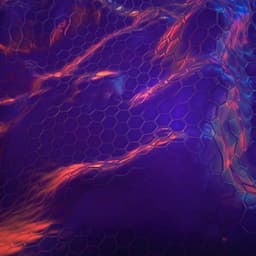
Physics
Replica higher-order topology of Hofstadter butterflies in twisted bilayer graphene
S. Kim, S. Jeon, et al.
This exciting research by Sun-Woo Kim, Sunam Jeon, Moon Jip Park, and Youngkuk Kim reveals the emergence of higher-order topological insulator phases in twisted bilayer graphene, showcasing localized corner states that act as dazzling replicas of original HOTIs. Discover the intriguing self-similarity of the Hofstadter spectrum and the role of flux translational symmetry in shaping these quantum fractals!
~3 min • Beginner • English
Introduction
Magnetic translational symmetry in crystals under a perpendicular magnetic field produces a self-similar (fractal) energy spectrum known as Hofstadter butterflies. Advances in van der Waals materials have enabled experimental observation of these spectra in graphene superlattices, twisted bilayer graphene (TBG), and related moiré systems by realizing large moiré unit cells that reduce the required field strength. Recent theory has linked magnetic translational symmetry to symmetry-protected topological phases, with effective time-reversal-like symmetries emerging at special flux values (e.g., half a flux period). This work asks whether higher-order topological insulator (HOTI) phases in TBG persist and replicate across the Hofstadter spectrum and what symmetries or mechanisms protect or generate them. The authors show that TBG at commensurate twist angles has an exact flux translational symmetry, implying a periodic Hofstadter spectrum in flux. They identify two original HOTIs at time-reversal-invariant fluxes (TRIFs) ϕ=0 and ϕ=Φ/2, a re-entrant HOTI at half-flux periodicity, and further replica HOTIs at specific rational fluxes set by a flux periodicity determined by the minimal Peierls path. They develop a real-space HOTI marker to diagnose these phases under open boundaries and finite magnetic field, including when conventional symmetry protections are absent.
Literature Review
The study builds on foundational work on magnetic translation groups and Hofstadter spectra and on experimental realizations of Hofstadter butterflies in graphene-based moiré systems. It connects to recent theoretical advances linking magnetic translational symmetry with crystalline topology and higher-order topology in magnetic fields. Prior works established HOTI phases in TBG protected by space-time-reversal (C2zT) and rotational symmetries (C2x), and explored fragile/Euler/Stiefel-Whitney band topology in moiré graphene. Comparative references include magic-angle TBG models where only C2zT is present and where re-entrant corner states at half periodicity were absent, highlighting the role of additional crystalline symmetry (C2x).
Methodology
- Lattice model: The Moon–Koshino atomistic tight-binding model for TBG is used: H = Σ_{i,j} t_{ij}(Ri − Rj) c_i^† c_j + h.c., with hopping amplitudes modeled as exponentially decaying with distance. The atomic structure corresponds to commensurate twist angles θ_min = arccos(m/2n) (m,n integers, m≠n), preserving C6z, C2x, and C2y.
- Magnetic field: A uniform perpendicular magnetic field is introduced via the Peierls substitution t_{ij}(Ri − Rj) → t_{ij}(Ri − Rj) exp(i ∫_{Rj}^{Ri} A·dr) using the Landau gauge A = B(0,x) (B along z). The minimal loop (minimal Peierls path) area S_min sets the flux period.
- Flux translational symmetry: For commensurate TBG, the authors prove exact flux periodicity at θ_min, quantified by N_rep = S_min / S_TBG = N / gcd(Z1,Z2,Z3), with N = m^2 + n^2 + mn, Z1 = m^2 − n^2, Z2 = 3 m^2, Z3 = 2 m^2 − m n + n^2. This yields a flux translation by Φ0 that can be implemented by a unitary gauge transformation U(A): H(ϕ+Φ0) = U(A) H(A) U^†(A). For θ=21.8° (m=1,n=2), N_rep=7.
- Symmetries with flux: The magnetic field breaks some crystalline symmetries but induces flux translation symmetry. Mirror-like behavior about TRIFs (ϕ=0, Φ/2) arises via C2x combined with gauge transformation U, giving spectral equivalence about TRIFs.
- Numerical calculations: Hofstadter spectra are computed using the kernel polynomial method (KPM). The density of states ρ(E) is expanded in Chebyshev polynomials and computed stochastically with random vectors and the Jackson kernel to mitigate Gibbs oscillations. Open boundary flakes are used to track edge/corner states and markers.
- Model parameters: Graphene bond length a0=1.42 Å, interlayer distance d0=3.35 Å, decay length δ=0.319 a0. Hopping amplitudes V_ppπ^0 = −2.7 eV, V_ppσ^0 = 0.82 eV with exponential distance dependence. The model reproduces a bulk gap ~9 meV at θ=21.8° in a HOTI state, with 14 occupied p_z bands (equal number of C2x=±1 bands) under periodic boundary conditions.
- HOTI diagnosis: Corner states are identified under open boundary conditions (diamond-shaped flakes). A real-space HOTI topological marker χ(r) = ⟨r| C_P X Q^† |r⟩ with C_P = P C2x P, P (Q) projection onto occupied (unoccupied) subspaces, and X the position operator, is introduced. Rotation-resolved markers x^±(r) are defined by projecting onto C2x = ±1 subspaces. Exponential localization of the marker from the edge indicates nontrivial rotation-winding topology; trivial phases show delocalized, approximately linear behavior in space.
- Flux sampling and angles: Spectral flow of highest occupied (HO) and lowest unoccupied (LU) states is tracked versus flux to detect discontinuities (bulk gap changes) and re-entrant behavior. Replica HOTIs are examined at fluxes ϕ = (p/N_rep) Φ (p integer, p not multiple of N_rep). Additional twist angles (13.2°, 9.4°) are studied; extracted N_rep values are 19 and 37, respectively. Flake sizes: 10×10 unit cells with 2800, 7600, and 14,800 atoms for 21.8°, 13.2°, and 9.4°, respectively.
Key Findings
- Exact flux translational symmetry: The full atomistic TBG model at all commensurate angles exhibits exact flux periodicity. For θ=21.8° (m=1,n=2), N_rep=7; the Hofstadter spectrum displays self-similarity with multiple replicas, including modulation reminiscent of graphene’s spectrum.
- Original HOTIs at TRIFs: TBG hosts HOTI phases at ϕ=0 and ϕ=Φ/2 (time-reversal-invariant fluxes). At ϕ=0, corner-localized modes appear within the bulk gap under open boundaries, consistent with a nontrivial second Stiefel-Whitney number and a nontrivial C2x rotation-winding number. The bulk gap at ϕ=0 is ~9 meV; a flake of width ~11 nm (≈2800 atoms) shows an energy gap of ~236 meV.
- Re-entrant HOTI at half-flux: A re-entrant HOTI phase occurs at half of the flux periodicity, protected by the composite symmetry U C2x that is exactly preserved there. HOTI markers x^+(r) remain edge-localized with an exponential decay exponent α≈0.52, identical to the zero-flux HOTI.
- Replica HOTIs at rational fluxes without explicit symmetry protection: Replicas of the original HOTIs appear at fluxes set by the quasi-periodicity ϕ = (p/N_rep) Φ with p ∈ Z and p not a multiple of N_rep. For θ=21.8°, these include fractions such as near 1/14, 1/7, 3/14, 2/7, 5/14, 3/7 (illustrated in magnified spectra). HO and LU states enter spectral gaps at these fluxes, showing corner localization.
- HOTI marker efficacy beyond symmetry-protected cases: Even when C2x and (C2xT)^2 symmetry conditions are broken at finite flux, the HOTI marker x^+(r) remains a quantitative diagnostic of HOTI phases. At small flux (e.g., ϕ = 2π/1000), x^+(r) is edge-localized with exponential decay α≈0.10 (weaker than α≈0.52 at TRIFs). In trivial cases (e.g., ϕ = 134π), x^+(r) shows linear delocalization across the sample.
- Origin of replica HOTIs: The replicas stem from different interaction scales (intralayer vs interlayer hoppings) and reduced interior area of the minimal Peierls path in TBG. When interlayer coupling is turned off, the composite symmetry U C2x becomes exact, clarifying the relation to the original HOTIs.
- Angle dependence: Replica HOTIs are found at other large twist angles. For θ=13.2° and 9.4°, N_rep=19 and 37, respectively. The HOTI marker’s localization weakens at smaller angles due to reduced bulk gaps.
- Symmetry requirement: The out-of-plane rotational symmetry C2x is essential to realize re-entrant and replica HOTIs under magnetic field. In contrast, a magic-angle TBG model with only C2zT symmetry shows no re-entrant corner state at half-flux periodicity, and the Stiefel-Whitney characterization becomes inapplicable with magnetic field.
Discussion
The work demonstrates that the self-similar Hofstadter spectrum in TBG hosts not only symmetry-protected HOTIs at special fluxes (TRIFs) but also a hierarchy of replica HOTIs at rational fluxes tied to flux periodicity determined by the minimal Peierls path. Exact flux translational symmetry at commensurate angles ensures spectral periodicity and, combined with C2x, explains mirror symmetries about TRIFs and the re-entrant HOTI at half-flux. The HOTI marker provides a robust, real-space tool to identify HOTI phases under open boundaries and finite magnetic fields, even when conventional symmetry-based topological invariants (e.g., Stiefel-Whitney numbers) are not applicable due to broken reality conditions and rotation symmetries. The findings clarify how different hopping scales (intra- vs interlayer) generate quasi-periodic replicas of topology and how edge localization of the marker quantifies topological phases and distinguishes them from trivial states. The contrast with magic-angle models lacking C2x highlights the crucial role of crystalline symmetry in stabilizing corner modes under field.
Conclusion
This study establishes that TBG at commensurate twist angles exhibits exact flux translational symmetry and supports higher-order topology across the Hofstadter spectrum. Original HOTIs appear at TRIFs (ϕ=0, Φ/2), a re-entrant HOTI emerges at half-flux, and replica HOTIs recur at rational fluxes set by N_rep. A real-space HOTI marker is introduced and validated as a quantitative diagnostic under open boundaries and finite fields, capturing both exact and replica HOTIs even without explicit protecting symmetries. These results uncover a symmetry-topology structure within quantum fractals and provide computationally efficient tools for low-field regimes.
Future directions include: establishing precise links between discrete scale invariance and band topology with experimental observables; addressing experimental challenges (e.g., stabilizing large TBG flakes at high fields and exploring different fillings that may reveal replica topology at lower fields); investigating Coulomb interactions at smaller angles where correlations are prominent; and extending the framework to generic moiré multilayers and quasiperiodic systems with multiple interaction scales.
Limitations
- Experimental feasibility: Observation of replica HOTIs at fixed filling may require extremely large magnetic fields (B ~ 10^5 T), posing major practical challenges and necessitating alternative fillings or conditions to access similar physics at lower fields.
- Symmetry dependence: Re-entrant and replica HOTIs under magnetic field rely on the presence of C2x symmetry; models lacking this symmetry (e.g., with only C2zT) do not show re-entrant corner states at half periodicity.
- Finite-size effects: Corner-state energy splitting and oscillatory behavior (Aharonov–Bohm-type) near HO/LU states arise from finite-size effects; results such as localization exponents may be geometry dependent.
- Angle dependence and gap size: At smaller twist angles the bulk gap diminishes, weakening marker localization and making HOTI signatures more fragile.
- Numerical approximations: KPM computations involve polynomial truncation and stochastic trace estimates; while efficient, they can introduce approximation errors that require convergence checks.
Related Publications
Explore these studies to deepen your understanding of the subject.







